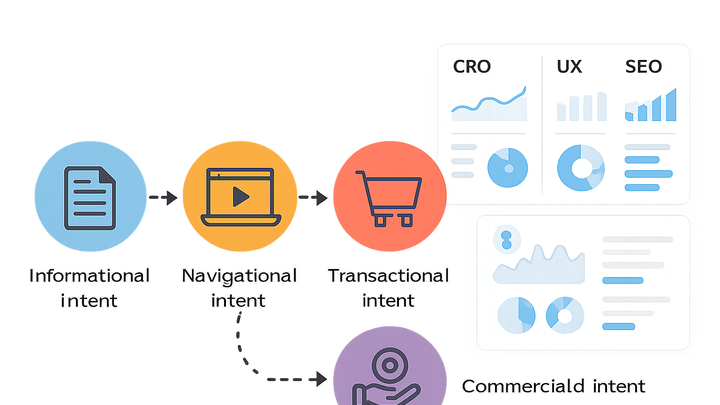Published on 2025-06-29T21:27:32Z
What is Buyer Intent? Examples for CRO, UX, and SEO
Buyer Intent refers to the underlying goal or motivation driving a user’s actions online. In the context of CRO, UX, and SEO, understanding buyer intent is crucial for aligning content, design, and messaging with what visitors are seeking at different stages of their journey. By identifying whether a user is looking for information, browsing options, or ready to purchase, marketers and product teams can tailor landing pages, calls to action, and site architecture to meet these needs effectively. Failure to address buyer intent can lead to high bounce rates, low engagement, and missed revenue opportunities. Tools like Prevue.me can surface key signals—such as navigation patterns, search queries, and on-page behavior—to help diagnose mismatches between page content and visitor goals. With the right data and testing framework, teams can refine their funnel to convert more qualified leads and improve overall user satisfaction. Ultimately, buyer intent bridges the gap between user motivations and business objectives by ensuring each touchpoint resonates with the visitor’s current mindset.
Buyer intent
User motivations guiding online actions, used to personalize CRO, UX, and SEO approaches for higher conversions.
Understanding Buyer Intent
In the realm of website critique for CRO, UX, and SEO, buyer intent refers to the purpose behind a user’s online actions. It categorizes visitor motivations into distinct types—such as seeking information, comparing options, or making a purchase decision. Recognizing these motivations helps teams design experiences that guide users toward desired outcomes.
-
Types of buyer intent
Buyer intent can be segmented into four primary categories to better align content and design with visitor goals.
- Informational intent:
Users are researching or learning about a topic without immediate conversion goals.
- Navigational intent:
Users aim to reach a specific website or brand page.
- Commercial investigation:
Users compare products or services before making a purchase decision.
- Transactional intent:
Users are ready to buy or complete a conversion action.
- Informational intent:
Importance in CRO, UX, and SEO
Properly aligning buyer intent with your optimization strategies can dramatically improve engagement, satisfaction, and conversion rates. Below are how each discipline benefits.
-
Conversion rate optimization (cro)
Mapping page content and calls to action to user intent reduces friction in the funnel and increases the likelihood of conversion.
-
User experience (ux)
Designing intuitive navigation and layouts that reflect visitor goals enhances usability and keeps users moving toward their objectives.
-
Search engine optimization (seo)
Targeting keywords that match user intent signals improves search rankings and attracts more qualified traffic.
Identifying Buyer Intent
Detecting buyer intent involves analyzing behavioral data, search queries, and user feedback. The following approaches and tools can surface actionable insights.
-
Analytics and behavioral data
Use performance metrics and user flows to uncover how visitors interact with your site.
- Google analytics:
Track goal completions, page paths, and bounce rates to infer visitor motivations.
- Prevue.me:
Provides actionable critiques for CRO, UX, SEO, and accessibility to highlight misalignments with buyer intent and recommend optimizations.
- Google analytics:
-
Keyword intent research
Analyze search terms with tools like Ahrefs or SEMrush to classify queries into intent categories.
-
User testing and feedback
Surveys, interviews, and usability tests reveal direct insights into why users visit and what they expect.
Optimizing for Buyer Intent
Once identified, buyer intent should guide content creation, design decisions, and SEO tactics to better serve visitor goals and drive conversions.
-
Content strategy
Develop messaging and resources that directly address each stage of the buyer journey.
- Targeted messaging:
Use language that resonates with the user’s current intent stage.
- Value proposition:
Highlight benefits that align with visitor goals at each intent level.
- Targeted messaging:
-
Ux design
Implement design patterns that reduce friction and lead users toward their objectives.
- Clear calls to action:
Match CTA labels to intent, such as ‘Learn More’ for informational users or ‘Buy Now’ for transactional users.
- Streamlined navigation:
Organize menus and links to support different user goals efficiently.
- Clear calls to action:
-
Seo tactics
Optimize on-page elements and metadata to reflect user intent and improve discoverability.
- Intent-focused keywords:
Select and integrate keywords that align with buyer intent classifications.
- Structured data:
Use schema markup to signal page purpose to search engines and enhance SERP features.
- Intent-focused keywords:
Examples of Buyer Intent in Action
Concrete examples help illustrate how understanding buyer intent can shape site elements and content strategies.
-
E-commerce website
Different user queries and behaviors demonstrate varying intent on an online retail site.
- Informational example:
A user searches ‘how to choose hiking boots’ and lands on a product guide page.
- Transactional example:
A user searches ‘buy waterproof hiking boots’ and proceeds to the checkout page.
- Informational example:
-
B2b saas landing page
A service-oriented site must cater to evaluators and buyers differently.
- Commercial investigation example:
A user compares feature lists and pricing tiers between platforms.
- Transactional example:
A user clicks ‘Start Free Trial’ or ‘Schedule a Demo’ based on purchase readiness.
- Commercial investigation example:
